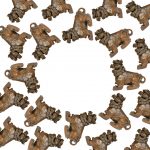PROJECT OVERVIEW:
In this project you will create molds of found objects, and then create multiples from your mold(s), and assemble these multiples into a larger sculpture.
————————————————————–
PART 1: WRITING ASSIGNMENT
At its best, sculpture is just as much about exploring ideas as it is about crafting objects. To develop the conceptual aspects of your project, please complete the writing assignment outlined below and post your work to the “research binder” section of the class website by following these instructions.
Please write a response that addresses all of the following questions in 100 – 200 words:
- What is your object in a direct, literal sense? (e.g. I have chosen to work with an urn, which is a metal vessel designed to store cremains.)
- What does your object denote –what does it signify, symbolize, or represent? (e.g. I think the urn denotes the human desire to preserve the deceased.)
- What connotations does your object carry — what undertones or associations? (e.g. The urn reminds me of ancient Egyptian canopic jars that held organs removed during the mummification process, and by extension it makes me think about hieroglyphics, pyramids, the sphinx, and other ancient Egyptian constructions that are intriguing because of their cryptic nature)
- How do you want your project to conceptually relate to the literal, denotative, and connotative ideas you’ve outlined above? Are there any particular ideas you want to explore or resist? Please explain.
Why we write about ideas: Every decision you make in the planning and execution of a work of art has meaningful implications. When one begins a project by thinking about what they want to accomplish in the end, it enables the artist to have more control over the final meaning in their work, AND it provides the artist with a useful tool for editing their work during the process of creating. While one could employ many methods for thinking critically, writing is especially helpful for developing this skill because it forces one to be precise and clarify ideas.
————————————————————–
PART 2: COLLAGE ASSIGNMENT (NOT REQUIRED IN SPRING SEMESTER 2023)
Create 5 different collages that demonstrate 5 distinctly different ways of bringing your cast objects together to create a finished work. In these collages, please strive to explore the concepts you’ve written about in a way that is inventive and thought provoking.
As you’re getting ready to create your collages, consider the particular ideas you addressed in your writing assignment– then think about the best way to arrange the objects you’ll be casting in order to address those ideas. Consider incorporating found objects and/or building some additional elements to produce a more dynamic finished product. In sculptural projects, ideas are often developed slowly over time through a process of making, reflecting, making, experimenting, reflecting, making, experimenting, etc. This collage exercise is a means of reflecting and experimenting that will help you create a stronger finished project.
Why collage? While sketching is generally a good method of working through ideas, since you’re working with multiples in this project, it would take a very long time to actually sketch out five detailed drawings of different solutions. However, on the computer you can easily create a number of images of whatever object(s) you’re molding, and then print these out. This is easy to do with Photoshop or even with Microsoft Word by just cutting a pasting a small image over and over again. Then, by printing and then cutting these images out and arranging them in various configurations, you can quickly visualize some possible end products.
The playfulness and easy experimentation of the collage process is highly conducive to the consideration of various possibilities. Writing will always have a place in the clarification of ideas, but the collage approach is valuable because it is a visual method for working through a visual problem. Collaging will allow you to quickly and vividly SEE what your end product may be, and I think you’ll find it quite useful. Feel free to simply bring hard copies of your collages, or if you prefer, you may submit your work digitally via the class website on the “research binder” page.
Examples – The collages included below were created last year by Sculpture 2 students to ideate for this project:
————————————————————–
PART 3: SKETCHES
So far you have done some writing to facilitate your critical thinking about the object you’ve selected, and you’ve created collages to help with the early stages of brainstorming; these steps have helped you find a direction for your project. However, in any sculptural project there are a lot of issues to figure out about how everything will come together in the end. Please create at least three detailed sketches of three distinctly different solutions for your project. Use these sketches as a means of visually thinking through the decisions that you still have to make, and further refining your vision for how the project will be resolved in the end.
————————————————————–
ADDITIONAL RESOURCES
Professor Meiser’s guide on casting materials
A selection of artists who work with multiples:
Katherina Frisch
http://www.designboom.com/art/katharina-fritsch-at-the-deichtorhallen-part-i/
Antony Gormley
Matthew Day Jackson
https://www.hauserwirth.com/artists/2827-matthew-day-jackson
http://hyperallergic.com/86125/matthew-day-jackson-too-big-too-failed/
http://www.grimmgallery.com/artists/matthew-day-jackson/
Images of past student projects
As you’re working to come up with ideas, it may be helpful to take a look at what students have created in previous semesters for the Accumulations project. Follow these links to see examples:
examples of past student projects mega-post
http://sculpture2.blogs.bucknell.edu/2018/02/25/project-1-accumulations-spring-2018/
http://sculpture2.blogs.bucknell.edu/2016/09/24/accumulations-project-1-fall-2016/
http://sculpture2.blogs.bucknell.edu/2014/03/02/project-1/
http://sculpture2.blogs.bucknell.edu/2013/02/20/project-1-documentation/
http://sculpture2.blogs.bucknell.edu/2012/03/06/accumulation-finished-photographs/
http://sculpture2.blogs.bucknell.edu/2013/01/14/examples-of-past-student-projects/


















